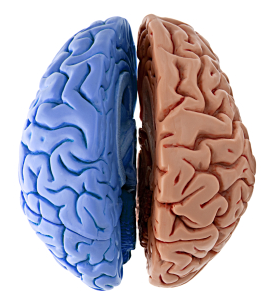One of the scariest events in pet parents’ lives is seeing their fur baby have a seizure. They’re downright frightening even when you know what seizures look like. So this week I’ve devoted some blog space to bring you important information about seizures in dogs and cats. Happy reading!
Seizures – What are they?
The simplest way to describe a seizure is as abnormal electrical activity in the brain. When this happens, the body suddenly shows neurologic signs, including loss of consciousness, involuntary muscle movements, and other disturbances of the senses.
Seizures – Are there different kinds?
Many pet parents may have heard the terms grand mal and petite mal seizures. These are commonly used in human medicine. In veterinary medicine, we don’t use these terms. Rather in dogs and cats, seizures are classified as generalized and focal/partial. So, what’s the difference?

The brain has two hemispheres or sides. Generalized seizures affect both hemispheres at their onset. These types of seizures are characterized by loss of consciousness and a variable degree of involuntary muscle movement. Indeed, generalized seizures can be sub-classified based on the type and degree of abnormal muscle activity. Generalized tonic-clonic seizures are the most common type of generalized seizures in pets. Initially a pet’s limbs stiffen (tonic phase) and then the limbs and jaw jerk (clonic phase). Other subtypes are:
- Myoclonic – these are characterized by brief jerks of muscles
- Absence – these are characterized by a short period of star-gazing or “spacing out”
- Atonic – these are characterized by sudden loss of muscle tone causing the pet to collapse
View the video below of a Siberian Husky having a generalized tonic-clonic seizure.
Focal/partial seizures don’t affect both hemispheres of the brain. Rather the abnormal electrical activity occurs in only one part of one hemisphere. Like generalized seizures, focal/partial ones can be sub-classified as simple or complex. Patients with simple focal seizures don’t lose consciousness while it is impaired or lost in those with complex focal seizures. To complicate classification, partial seizures can progress to generalized ones, and these are termed focal seizures secondarily generalized.
Seizures – What causes them?
Not all seizures are created equally. That’s because there are numerous triggers for abnormal electrical activity in the brain! To make things as simple as possible, I like to think of seizures having either an intracranial (inside the brain) or extracranial (outside the brain) origin. As a board-certified veterinary internal medicine specialist, I’m frequently referred patients with seizure disorders to help determine if there is an extracranial cause, such as:
- Intoxications (i.e.: lead, organophosphates, strychnine, bromethalin, metaldehyde, pyrethrins, etc.)
- Metabolic diseases (including liver and kidney dysfunction)
- Infectious agents
- Glucose (blood sugar) derangements
- Electrolyte (i.e.: sodium, potassium, chloride, magnesium) and mineral (i.e.: calcium) abnormalities
- Lipid (blood fat) abnormalities
- Hypertension (high blood pressure)
Intracranial causes are somewhat less complicated. There is either a structural lesion in the brain or there isn’t. When a structural lesion is present, we use the term secondary or acquired epilepsy. A structural lesion could be an actual brain tumor but could also be a scar from previous trauma or infection. A vascular accident (otherwise called a stroke) can also cause a structural abnormality. When no structural lesion is present, veterinarians use the term primary/idiopathic/genetic epilepsy.
A pet’s age and breed can provide clues as to the potential underlying cause of the seizure. Puppies and kittens are more likely to have a congenital disorder and geriatric pets most commonly have grain tumors. Primary/idiopathic/genetic epilepsy is usually diagnosed between 1-6 years of age. Toy breed dogs, particularly Yorkshire terriers, frequently have low blood sugar (hypoglycemia), congenital liver problems, and/or immune-mediated diseases of the brain. Other breeds as predisposed to primary/idiopathic/genetic epilepsy, including:
- Australian shepherds
- Beagles
- Belgian Tervurens
- Border collies
- Boxers
- Cocker spaniels
- Dachshunds
- German shepherds
- Golden retrievers
- Irish setters
- Keeshonds
- Labrador Retrievers
- Poodles
- Saint Bernards
- Shetland sheepdogs
- Siberian huskies
- Springer Spaniels
- Welsh corgis
- Wirehair fox terriers
- Vizslas
Seizures – How are they diagnosed?
Veterinarians will need to obtain a thorough patient history and perform a complete physical examination for patients with seizure disorders. It is often uniquely helpful if parents can video record a pet’s seizure, but understandably this can be challenging in the heat of the moment. Pet parents should be prepared to answer the following questions:
- What does the seizure look like from start to finish?
- When do they seizures occur?
- How long do the seizures last?
- Is the pet normal between seizures?
- Does your pet have any pre-existing medical conditions?
- Have you travelled with your pet outside your geographic location?
In effort to identify extracranial causes of seizures, veterinarians will perform some non-invasive blood and urine testing to screen for metabolic disorders, blood sugar and electrolyte abnormalities, and potential infectious diseases. They will also measure your fur baby’s blood pressure. Partnering with a board-certified veterinary internal medicine specialist can be instrumental in developing a cost-effective and logical diagnostic plan.
Should these tests not identify an obvious extracranial cause for a pet’s seizure, then the diagnostic investigation should turn toward a search for a potential intracranial one. Identification of a structural lesion requires diagnostic imaging of the brain and potentially sampling of cerebrospinal fluid (CSF). Radiographs/x-rays don’t adequately penetrate the skull to provide detailed pictures of brain structures. To appropriately image the brain, veterinarians must use advanced imaging in the form of magnetic resonance imaging (MRI) or computed tomography (CT). Understandably, primary care veterinarians typically aren’t able to perform these imaging studies, and thus consultation with a board-certified veterinary neurologist is uniquely helpful.
Remember this important point. Only when extracranial causes are appropriately ruled out and no secondary cause of epilepsy is discovered can a veterinarian make a diagnosis of primary/idiopathic/genetic epilepsy. In my clinical experience, most pet parents readily allow veterinarians to look for extracranial causes of seizures. However, they rarely complete a thorough diagnostic investigation that includes advanced imaging of the brain to rule out secondary epilepsy.
Seizures – What do I do when they occur?
It’s difficult not to panic when one’s fur baby has a seizure for the first time. Following a pet’s first seizure, a veterinarian should evaluate the patient as soon as possible to determine the underlying cause. If possible, one should time the duration of a dog’s or cat’s seizure. Thankfully most seizures are short in duration. Yet, I guarantee it will feel like an eternity for it to stop! Any seizure that lasts more than five minutes is considered a true emergency because body temperatures can rise to dangerously high levels due to the abnormal muscle activity. A veterinarian should evaluate such pets as soon as possible. Make sure seizing pets are in a safe place, but avoid placing one’s fingers and/or face near the mouths of affected animals. For pets with chronic seizure disorders, I strongly encourage pet parents to keep a detailed journal of their pet’s seizure activity. This data can be helpful for objectively identifying trends and changes in an animal’s seizure activity, and thus influence potential treatments.

Seizures – How are they treated?
The reason it’s so important to determine the definitive cause of a pet’s seizure disorder is because it helps dictate proper treatment. A cat with low blood sugar needs sugar. A dog with high blood pressure needs medication to bring its blood pressure down to normal. A pet with a brain tumor often benefits from surgery and/or radiation therapy.
Many patients with primary/idiopathic/genetic and secondary epilepsy require therapy with at least one anti-seizure medication. Some common anti-convulsant drugs used in dogs and cats are:
- Phenobarbital
- Potassium bromide
- Levetiracetam
- Zonisamide
- Clorazepate
- Felbemate
- Gabapentin
Partnering with a board-certified veterinary neurologist is invaluable when determining the most effective therapeutic plan for a pet with a seizure disorder.
The take-away about seizures in dogs and cats…
Seizures are scary. When they happen, pet parents need to be prepared. There are different types of seizures, each with different potential causes. Families should work closely with their family veterinarian and board-certified veterinary specialists in internal medicine and neurology to both determine the cause of a pet’s seizure and the most effective treatment.
To find a board-certified veterinary neurologist, please visit the American College of Veterinary Internal Medicine.
To find a board-certified veterinary internal medicine specialist, please visit the American College of Veterinary Internal Medicine.
Wishing you wet-nosed kisses,
cgb






